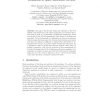Free Online Productivity Tools
i2Speak
i2Symbol
i2OCR
iTex2Img
iWeb2Print
iWeb2Shot
i2Type
iPdf2Split
iPdf2Merge
i2Bopomofo
i2Arabic
i2Style
i2Image
i2PDF
iLatex2Rtf
Sci2ools
EUC
2005
Springer
2005
Springer
Evaluation of Space Allocation Circuits
This paper describes the design and evaluation of the PCA (Plastic Cell Architecture) cell, which implements a novel space allocation method. PCA is a dynamically reconfigurable architecture which exceeds the FPGA (Field Programmable Gate Array) in flexibility and generality. Circuit dynamically reconfiguration is achieved as administrators manage the heap areas. But, because objects operate and require new space in parallel, it is difficult to manage them collectively. So, we introduced the concept of pressure, which enables space allocation. As a simulation result, we found that this new method, which relies on pressure commands, could solve the problems of object management efficiently. We designed the PCA cell with space allocation capability. Consequently, the number of gates per PCA cell is 200, and the maximum delay time per cell is 3.55 ns. Moreover, the 3 × 3 PCA cell processing of six space-allocation commands consumes 306.3µW.
Related Content
| Added | 27 Jun 2010 |
| Updated | 27 Jun 2010 |
| Type | Conference |
| Year | 2005 |
| Where | EUC |
| Authors | Shinya Kyusaka, Hayato Higuchi, Taichi Nagamoto, Yuichiro Shibata, Kiyoshi Oguri |
Comments (0)

